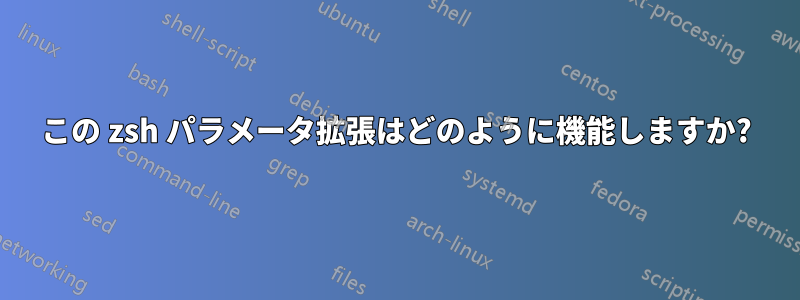
このパラメータ拡張を含むzshスクリプトを見つけました
${LBUFFER%%(#m)[_a-zA-Z0-9]#}
この表現がどのような文脈で使われているのか知りたい人は、vimのような略語を提供するzleウィジェット関数
その基本形は明らかに接尾辞のトリムです。つまり${name%%pattern}
つまりman zshexpn、パラメータ拡張から
${name%pattern} ${name%%pattern} If the pattern matches the end of the value of name, then sub‐ stitute the value of name with the matched portion deleted; [...]
に関してパラメータ拡張フラグ (#m): からman zshexpn
# Evaluate the resulting words as numeric expressions and output the characters corresponding to the resulting integer. Note that this form is entirely distinct from use of the # without parentheses. m Only useful together with one of the flags l or r or with the # length operator when the MULTIBYTE option is in effect. Use the character width reported by the system in calculating how much of the string it occupies or the overall length of the string. Most printable characters have a width of one unit, however cer‐ tain Asian character sets and certain special effects use wider characters; combining characters have zero width. Non-printable characters are arbitrarily counted as zero width; how they would actually be displayed will vary.
部分に関しては[_a-zA-Z0-9]#、これは明らかに文字列の末尾から削除されるパターンですLBUFFERが、これは正規表現パターンですか、それとも正規表現グロブのハイブリッドですか?
これはzsh固有の「extended_glob」パターンの一部ですか?つまり、man zshoptions
EXTENDED_GLOB Treat the `#', `~' and `^' characters as part of patterns for filename generation, etc. (An initial unquoted `~' always pro‐ duces named directory expansion.)
この zsh パラメータ拡張は何をしますか?
答え1
それは zsh の「拡張 glob」表現のようです。
つまりman zshexpn
グロブ フラグ 囲ん
でいるグループの終わりまで、またはパターンの終わりまでの右側のテキストに影響を与えるさまざまなフラグがあります。これらのフラグには EXTENDED_GLOB オプションが必要です。すべてのフラグは (#X) という形式を取ります。ここで、X は次のいずれかの形式になります。[...]
m
一致した文字列全体の一致データへの参照を設定します。これはバックリファレンスに似ており、ファイル名の生成では機能しません。フラグはパターンの最後で有効である必要があります。つまり、グループに対してローカルではありません。パラメータ $MATCH、$MBEGIN、および $MEND は、それぞれ一致した文字列と文字列の先頭と末尾のインデックスに設定されます。これは、パラメータ置換で最も役立ちます。そうしないと、一致した文字列が明らかになります。例えば、
arr=(veldt jynx grimps waqf zho buck) print ${arr//(#m)[aeiou]/${(U)MATCH}}一致したすべての文字(つまり、すべての母音)を大文字に変換し、`vEldt jynx grImps wAqf zhO buck' と出力します。後方参照とは異なり、一致参照を使用する場合、示されている例のような場合に置換文字列に必要な追加の置換を除いて、速度の低下はありません。
そして、#演算子はいわゆる「閉包」または繰り返し一致演算子であり、*正規表現の
ここで説明されているようにhttp://zsh.sourceforge.net/ガイド/zshguide05.html#l139
つまり、基本的にこのパラメータ拡張は次のようになります。
${LBUFFER%%(#m)[_a-zA-Z0-9]#}
は、 から始まる正規表現スタイルの後方参照を開始します。ここで、一致したパターンは、 BRE やPCRE のように(#m)変数で使用できます。 は とまったく同じなので、は文字セット の 0 個以上の文字と一致します。$MATCH\1$1#*[_a-zA-Z0-9]#[_a-zA-Z0-9]


